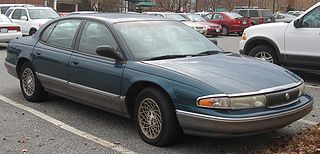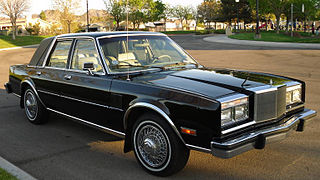Dodge is an American brand of automobiles and a division of Stellantis North America, based in Auburn Hills, Michigan. Dodge vehicles have historically included performance cars, and for much of its existence Dodge was Chrysler's mid-priced brand above Plymouth.

The Chrysler New Yorker is an automobile model that was produced by Chrysler from 1940 until 1996, serving for several decades as either the brand's flagship model or as a junior sedan to the Chrysler Imperial, the latter during the years in which the Imperial name was used within the Chrysler lineup rather than as a standalone brand.

The Chrysler Fifth Avenue was a trim level/option package or model name used by Chrysler for its larger sedans from 1979 to 1993. The Fifth Avenue name was no longer used after 1993 when Chrysler introduced its new LH-platform New Yorker and similar LHS. The title "Fifth Avenue" references a street in New York City which contains many upscale shops and cultural attractions. The Chrysler Building is two blocks east of Fifth Avenue.

The Dodge Dart is a line of large passenger cars produced by Dodge from the 1959 to 1976 model years in North America, with production extended to later years in various other markets.
Chrysler's C platform was the basis for rear wheel drive full-size cars from 1965 to 1978. Although often misclassified, 1964 and earlier full-size Chrysler products, and 1966 and earlier Imperials are not C-bodies.

The Chrysler M Platform was an intermediate-sized automobile platform used by Chrysler motors from 1977 to 1989. It was a successor to the F-body, as used on the Dodge Aspen/ Plymouth Volare. The M-body was also the successor to the short-lived R-body, as the Chrysler New Yorker and Plymouth Gran Fury moved to it following the R-body's demise in 1981. The M platform was the final production passenger car with a solid rear axle mounted on Hotchkiss-style, parallel semi-elliptical leaf springs sold in the U.S.

The Dodge Magnum is a nameplate used by several Dodge vehicles, at different times and on various markets. The name was first applied to a large Chrysler B platform-based 2-door coupe marketed from 1978 to 1979 sold in the United States and Canada. From the 2005 to the 2008 model years, the nameplate was revived for a Charger-based station wagon on the rear-wheel drive Chrysler LX platform, produced in Canada and sold on the American and Canadian market.

Full-size car—also known as large car—is a vehicle size class which originated in the United States and is used for cars larger than mid-size cars. It is the largest size class for cars. In Europe, it is known as E-segment or F-segment.

The Dodge Aspen, and the nearly-identical PlymouthVolaré, are compact cars that were produced from 1976 until 1980. The Volaré/Aspen model line offered a four-door sedan, a two-door coupe, and a four-door wagon.

The Dodge Diplomat is an American mid-size car that was produced by Dodge from 1977 to 1989. At launch, it shared a common design with the Chrysler LeBaron and for much of its later production run was the counterpart of the more upscale Chrysler Fifth Avenue and lower priced Plymouth Gran Fury. It was also sold in Mexico between 1981 and 1982 as the Dodge Dart, and in Colombia as the Dodge Coronet. The Diplomat was initially offered in a coupe and a sedan; in 1978, station wagons were added as replacements for the discontinued full-sized C-body wagons.

The Dodge Monaco is an automobile that was marketed by the Dodge division of Chrysler Corporation. Introduced as the flagship of the Dodge product line, the Monaco was introduced for 1965 to replace the Custom 880, then later joining as a sub-model of the Dodge Polara. During its production, the Monaco was offered in multiple body configurations, including two-door and four-door hardtop sedans, four-door sedans, two-door convertibles, and station wagons.

The Dodge Coronet is an automobile that was marketed by Dodge in seven generations, and shared nameplates with the same bodyshell with varying levels of equipment installed. Introduced as a full-size car in 1949, it was the division's highest trim line and moved to the lowest level starting in 1955 through 1959. The name was reintroduced on intermediate-sized models from the 1965 until 1976 model years. Muscle car versions were available starting in 1965 with the 383 and 426 wedge cu in Chrysler RB engine, followed in 1966 by the powerful 426 cu in Chrysler Hemi. Other performance models included the "Superbee", and featured, the 383 cu in Magnum, among other engine options. The nameplate "coronet" is a type of crown worn by royalty.

The Plymouth Fury is a model of automobile that was produced by Plymouth from 1955 until 1989. It was introduced for the 1956 model year as a sub-series of the Plymouth Belvedere, becoming a separate series one level above the contemporary Belvedere for 1959. The Fury was a full-size car from 1959 until 1961, then a mid-size car from 1962 until 1964, again, a full-size car from 1965 through 1974, and again, a mid-size car from 1975 through 1978. From 1975 until 1977, the Fury was sold alongside the full-size Plymouth Gran Fury. In 1978, the B-body Fury was the largest Plymouth, and by 1979, there was no large Plymouth. This product gap was filled in 1980 with the R-body Gran Fury, followed by the M-body Fury in 1982. Production of the last V8, RWD Plymouth Fury ended at the Kenosha Main assembly plant in Kenosha, WI, on December 23, 1988. Unlike its sibling brand, Dodge, Plymouth would not live to see the resurgence of the large, V8/RWD sedan.

The Chrysler R platform was introduced for the 1979 model year. The first example of downsizing of the full-size Chrysler sedan line, the R-body is an evolution of the B-body intermediate chassis. Competing against the downsized General Motors B-body chassis and the all-new Ford Panther chassis, the R-body is the longest-wheelbase of the three. In contrast to Ford and GM, Chrysler only marketed the R-body as a four-door sedan.

The Chrysler Town & Country is an automobile which was manufactured by Chrysler from 1940 to 1942 and from 1945 to 1988 with production interrupted during World War II. Primarily produced as a luxury station wagon, the Town & Country was also available in "woodie" four-door sedan, two-door hardtop and convertible body styles from 1947 to 1950, 1968 to 1969 and from 1983 to 1986. The 1988 model year was the last for the station wagon until the 1990 model year when Chrysler reintroduced the Town & Country nameplate as the rebadged variant Chrysler Town & Country minivan.

The Dodge Polara is an automobile introduced in the United States for the 1960 model year as Dodge's top-of-the-line full-size car. After the introduction of the Dodge Custom 880 in 1962, the Polara nameplate designated a step below the full-sized best-trimmed Dodge model; the Polara that year had been downsized to what was in effect intermediate, or mid-size status. In its various forms, the Polara name was used by Dodge until 1973, when its position in Dodge's line-up was replaced by the Dodge Monaco.

The Plymouth Gran Fury is a full-sized automobile that was manufactured by Plymouth from 1975 to 1989. The nameplate would be used on successive downsizings, first in 1980, and again in 1982, through what would originally have been intermediate and compact classes in the early 1970s, all with conventional rear-wheel drive layouts. By the time Chrysler ended M-body production in December 1988, they were Chrysler's last remaining rear-wheel drive cars, with a V8 and carburetor, a configuration used since the mid-1950s. Plymouth did not have another rear-wheel drive car until the 1997 Prowler roadster.

The Newport was a name used by Chrysler for both a hardtop body designation and also for its lowest priced model between 1961 and 1981. Chrysler first used the Newport name on a 1940 show car, of which five vehicles were produced. From 1950 to 1956, the Newport name was then used to designate any Chrysler model with a hardtop body style. In 1961, Chrysler introduced the Newport as a new, low-priced model, offering large, comfortable two- and four-door Chrysler models that were modestly priced compared with the Chrysler 300, the Chrysler New Yorker and the Imperial. For 1961, the Newport was priced below the Chrysler Windsor in the Windsor's final year.
In the context of the automobile industry, downsizing is a practice used to transition vehicles from one size segment to another. Commenced during the Malaise era, downsizing is done in response to consumer and government demands influencing vehicle design. As vehicle product lines completed their model cycles, automobile manufacturers developed the next generation of a vehicle with a smaller exterior footprint to allow for weight reduction and increased fuel economy, using a shortened wheelbase and body length.
Chrysler is a brand of North American vehicles owned by Stellantis. The automaker was founded in 1925 by Walter Chrysler from the remains of the Maxwell Motor Company. The brand primarily focused on building luxury vehicles as the broader Chrysler Corporation expanded, following a strategy of brand diversification and hierarchy largely adopted from General Motors. However, the company and the brand have struggled to adapt to changing markets. As of 2024, the company's vehicle lineup solely consists of the Pacifica minivan.




















